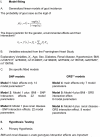Serum urate gene associations with incident gout, measured in the Framingham Heart Study, are modified by renal disease and not by body mass index
- PMID: 26427508
- PMCID: PMC4724568
- DOI: 10.1007/s00296-015-3364-4
Serum urate gene associations with incident gout, measured in the Framingham Heart Study, are modified by renal disease and not by body mass index
Abstract
We hypothesized that serum urate-associated SNPs, individually or collectively, interact with BMI and renal disease to contribute to risk of incident gout. We measured the incidence of gout and associated comorbidities using the original and offspring cohorts of the Framingham Heart Study. We used direct and imputed genotypes for eight validated serum urate loci. We fit binomial regression models of gout incidence as a function of the covariates, age, type 2 diabetes, sex, and all main and interaction effects of the eight serum urate SNPs with BMI and renal disease. Models were also fit with a genetic risk score for serum urate levels which corresponds to the sum of risk alleles at the eight SNPs. Model covariates, age (P = 5.95E-06), sex (P = 2.46E-39), diabetes (P = 2.34E-07), BMI (P = 1.14E-11) and the SNPs, rs1967017 (P = 9.54E-03), rs13129697 (P = 4.34E-07), rs2199936 (P = 7.28E-03) and rs675209 (P = 4.84E-02) were all associated with incident gout. No BMI by SNP or BMI by serum urate genetic risk score interactions were statistically significant, but renal disease by rs1106766 was statistically significant (P = 6.12E-03). We demonstrated that minor alleles of rs1106766 (intergenic, INHBC) were negatively associated with the risk of incident gout in subjects without renal disease, but not for individuals with renal disease. These analyses demonstrate that a significant component of the risk of gout may involve complex interplay between genes and environment.
Keywords: Genetic urate score; Gout comorbidities; Metabolic syndrome; Obesity.
Figures



References
-
- Arromdee E, Michet CJ, Crowson CS, et al. Epidemiology of gout: is the incidence rising? J Rheumatol. 2002;29:2403–2406. - PubMed
Publication types
MeSH terms
Substances
Grants and funding
- VA999999/ImVA/Intramural VA/United States
- U01 AG018947/AG/NIA NIH HHS/United States
- U34 AR062891/AR/NIAMS NIH HHS/United States
- P30 DK056336/DK/NIDDK NIH HHS/United States
- P50 AR060772/AR/NIAMS NIH HHS/United States
- R01 DK062148/DK/NIDDK NIH HHS/United States
- N02 HL064278/HL/NHLBI NIH HHS/United States
- U19 HS021110/HS/AHRQ HHS/United States
- U10 CA149950/CA/NCI NIH HHS/United States
- N01 HC025195/HL/NHLBI NIH HHS/United States
- K01 DK095032/DK/NIDDK NIH HHS/United States
- K01 AR060848/AR/NIAMS NIH HHS/United States
LinkOut - more resources
Full Text Sources
Other Literature Sources
Medical

